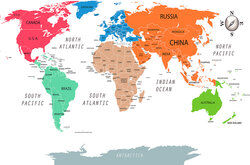Albania is perhaps the least-known region in Europe; and though more than a hundred years have passed since Gibbon described it as "a country within sight of Italy, which is less known than the interior of America," but little progress has yet been made towards a scientific knowledge of this interesting land and its inhabitants.
The wild and inaccessible character of the country, the fierce and lawless disposition of the people, the difficulties presented by their language and their complex social institutions, and the inability of the Turkish authorities to afford a safe conduct in the remoter districts, combine to render Albania almost unknown to the foreign traveller, and many of its geographical problems still remain unsolved.
North-eastern Albania forms part of the Turkish vilayet of Kossovo; the northern highlands are included in the vilayet of Shkodra (Scutari), the eastern portion of central Albania belongs to the vilayet of Monastir, and the southern districts are comprised in the vilayet of Iannina.
The highland region of northern Albania is divided into two portions by the lower course of the Drin; the mountains of the northern portion, the Bieska Malziis, extend in a confused and broken series of ridges from Scutari to the valleys of the Ibar and White Drin; they comprise the rocky group of the Prokletia, or Accursed Mountains, with their numerous ramifications, including Mount Velechik, inhabited by the Kastrat and Shkrel tribes, Bukovik by the Hot, Golesh by the Klement, Skulsen (7533 ft.), Baba Vrkh (about 7306 ft.), Maranay near Scutari, and the Bastrik range to the east.
Southern Albania, again, is almost wholly mountainous, with the exception of the plains of Iannina and Arta; the most noteworthy feature is the rugged range of the Tchika, or Khimara mountains, which skirt the sea-coast from south-west to northeast, terminating in the lofty promontory of Glossa (ancient Acroceraunia).




